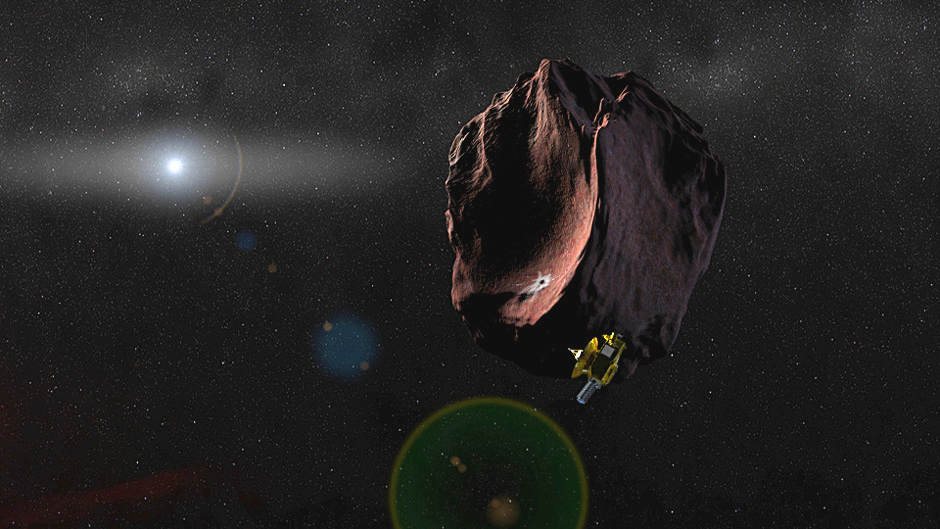
It may not seem like it, but it is approaching two years now since New Horizons made its historic flyby of Pluto and its moons in July 2015. But even though it has been quiet since then, the mission continues, as the spacecraft is now preparing for its next flyby of another Kuiper Belt Object (KBO) on Jan. 1, 2019 – and now New Horizons has reached the halfway point between Pluto and the next target, called 2014 MU69. It’s another major milestone for a mission that gave us our first close-up views of the Pluto system, and revealed worlds utterly alien and unique in the Solar System.
“It’s fantastic to have completed half the journey to our next flyby; that flyby will set the record for the most distant world ever explored in the history of civilization,” said Alan Stern, New Horizons principal investigator from the Southwest Research Institute in Boulder, Colorado.
New Horizons officially reached the halfway point at midnight (UTC) on April 3 – or 8 p.m. ET on April 2. As of then, it was 486.19 million miles (782.45 million kilometers) from both Pluto and 2014 MU69. There is another related milestone coming up later this week as well, when New Horizons will reach the halfway point in time between its closest approaches to Pluto, which occurred at 7:48 a.m. ET on July 14, 2015, and 2014 MU69, which is predicted for 2 a.m. ET on Jan. 1, 2019. This is a little different from the previous halfway point due to the gravitational pull of the Sun on the spacecraft; as New Horizons gets farther from the Sun, it slows down slightly in speed. The effect is that the spacecraft crosses the halfway point in distance about five days before it crosses the halfway point in time.
New Horizons is now traveling in a very remote and unexplored region of the Solar System. It is the first spacecraft to ever approach Pluto or other KBO objects, so we are seeing these worlds for the first time in human history. As long as the spacecraft remains healthy and functioning, the New Horizons team wants to have a look at other KBOs as well, even past 2014 MU69.
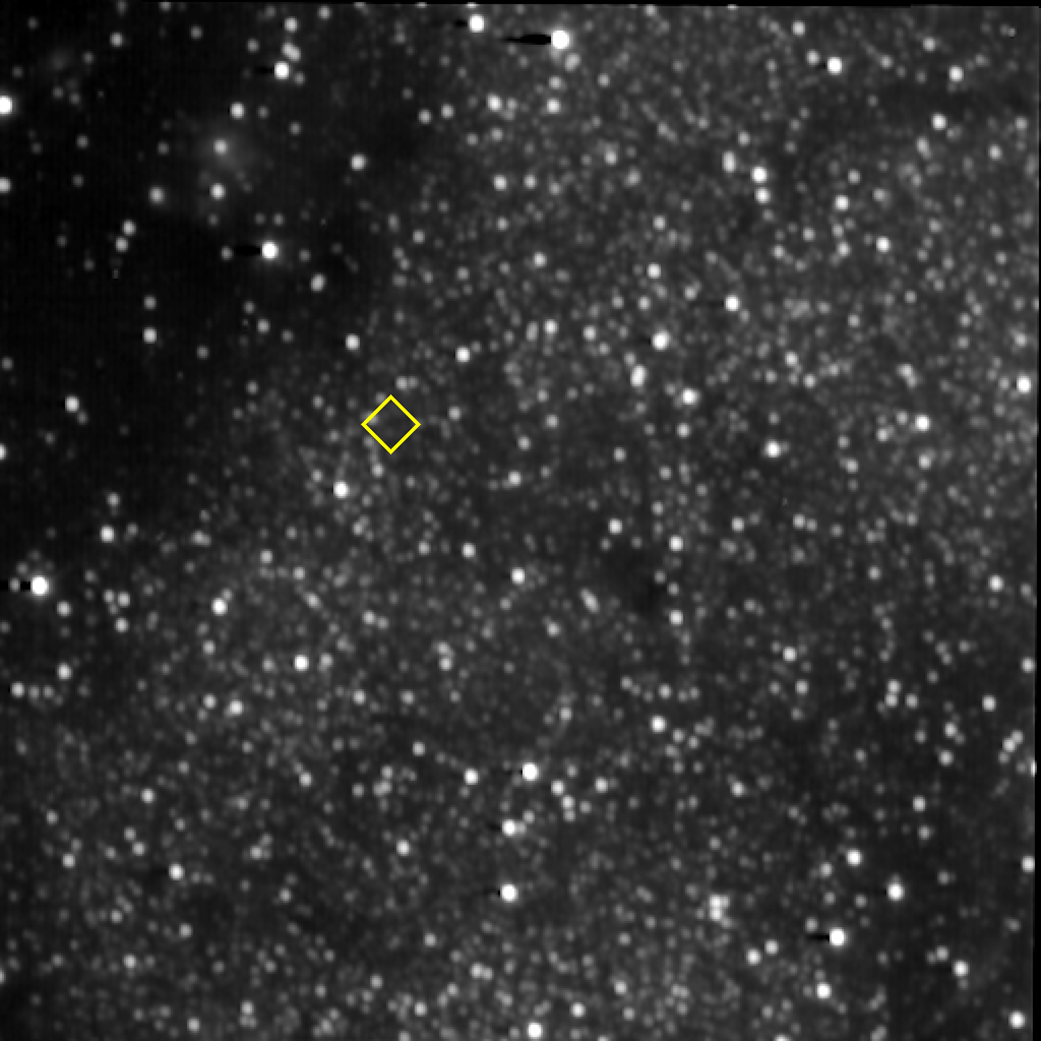
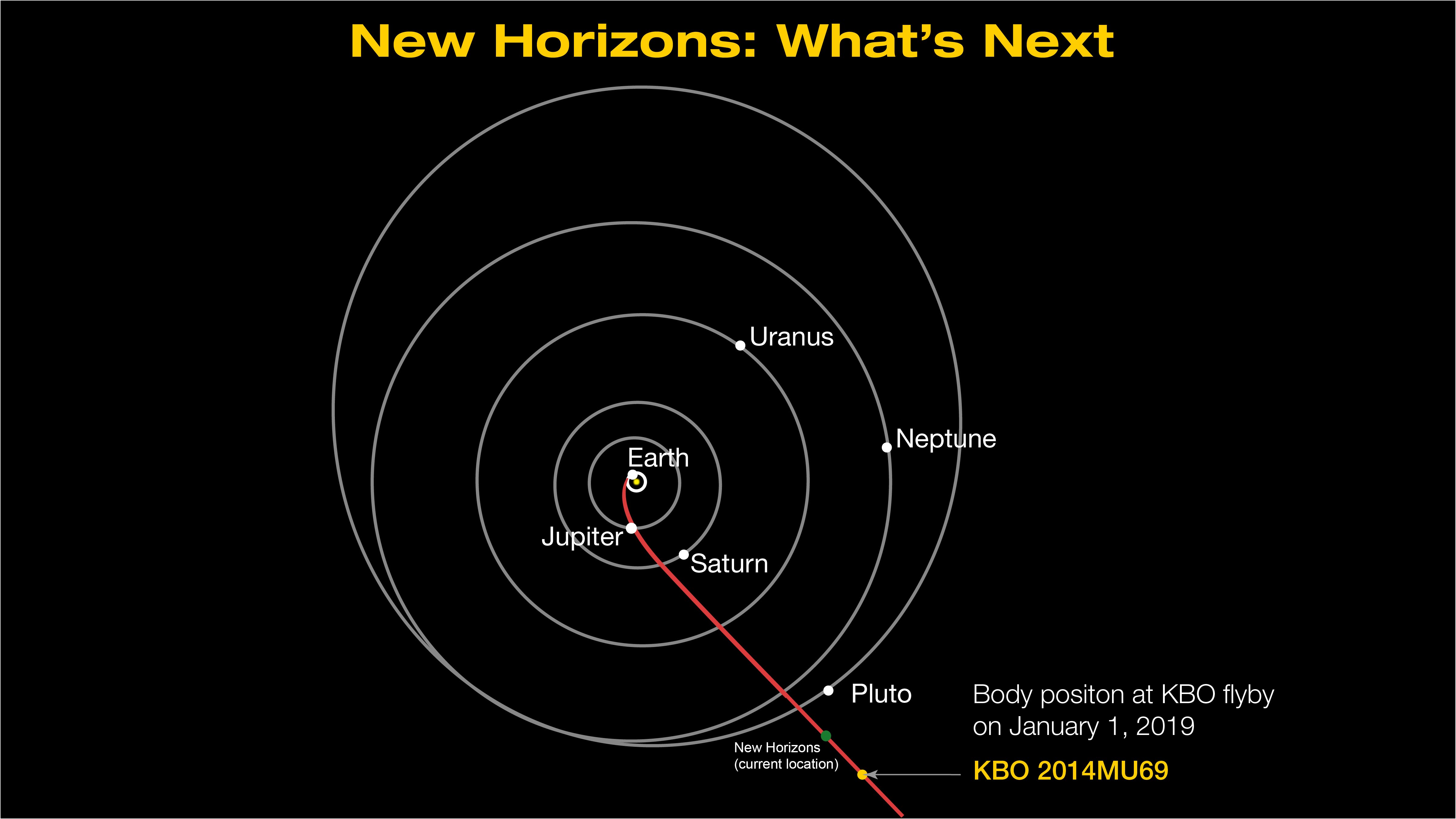
“The January 2019 MU69 flyby is the next big event for us, but New Horizons is truly a mission to more broadly explore the Kuiper Belt,” said Hal Weaver, New Horizons project scientist from APL, in Laurel, Maryland. “In addition to MU69, we plan to study more than two-dozen other KBOs in the distance and measure the charged particle and dust environment all the way across the Kuiper Belt.”
Last February, New Horizons successfully completed a slight course adjustment, to keep it on track for its encounter with 2014 MU69. The spacecraft’s thrusters fired (burned), as planned, for 44 seconds. This adjusted the velocity of the spacecraft by about 44 centimeters per second, or a little less than one mile per hour.
“One mile per hour may not sound like much,” said Stern, “but over the next 23 months, as we approach MU69, that maneuver will add up to an aim point refinement of almost six thousand miles (10,000 kilometers).”
Four similar adjustments had been made in late 2015 as well. They helped to correct for refined measurements of 2014 MU69’s orbit from the Hubble Space Telescope. Besides the burn, the spacecraft also transitioned out of the “three-axis stabilized mode” that allowed New Horizons to make new telescopic observations of six other distant KBOs.
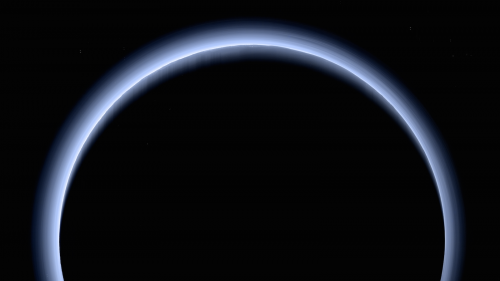
After the second halfway point has been passed, New Horizons go into “hibernation” for 157 days, for a well-deserved rest of sorts.
2014 MU69 is much smaller than Pluto, only about 13 to 25 miles (21 to 40 kilometers) across, and orbits much farther from the Sun, at 4 billion miles (6.4 billion kilometers) away. Even though it is tiny, New Horizons will fly past the KBO at a much closer distance than it did Pluto – only about 1,900 miles (3,000 kilometers) from the surface. Assuming all goes well, the images sent back should be spectacular. Studying other KBOs besides Pluto will help scientists understand just how they originated; they are thought to be rocky and icy relics left over from the formation of the Solar System billions of years ago, just like other asteroids and comets. Pluto, as now classified, is simply the largest known KBO.
“Even as the New Horizon’s spacecraft speeds away from Pluto out into the Kuiper Belt, and the data from the exciting encounter with this new world is being streamed back to Earth, we are looking outward to the next destination for this intrepid explorer,” said John Grunsfeld, chief of the NASA Science Mission Directorate in Washington.
As Stern also explained, “The Kuiper Belt is a rich scientific frontier. Its exploration has important implications for better understanding comets, the origin of small planets, the Solar System as a whole, the solar nebula, and dusty Kuiper Belt-like disks around other stars, as well as for studying primitive material from our own Solar System’s planet formation era. The exploration of the Kuiper Belt and KBOs like MU69 by New Horizons would transform Kuiper Belt and KBO science from a purely astronomical pursuit, as it is today, to a geological and geophysical pursuit.”
The flyby of 2014 MU69 is part of the Kuiper Belt Extended Mission (KEM), which is planned to continue until at least 2021. The main objectives of this part of the mission include:
- Make distant flyby observations of about 20 other KBOs during 2016-2020, determining their shapes, satellite populations, and surface properties – something no other mission or ground-based telescope can.
- Make sensitive searches for rings around a wide variety of KBOs during 2016-2020.
- Conduct a heliospheric transect of the Kuiper Belt, making nearly continuous plasma, dust, and neutral gas observations from 2016 to 2021, when the spacecraft reaches 50 astronomical units (AU) from the Sun.
- Potentially conduct astrophysical cruise science in 2020 and 2021, after the MU69 flyby, if NASA desires.
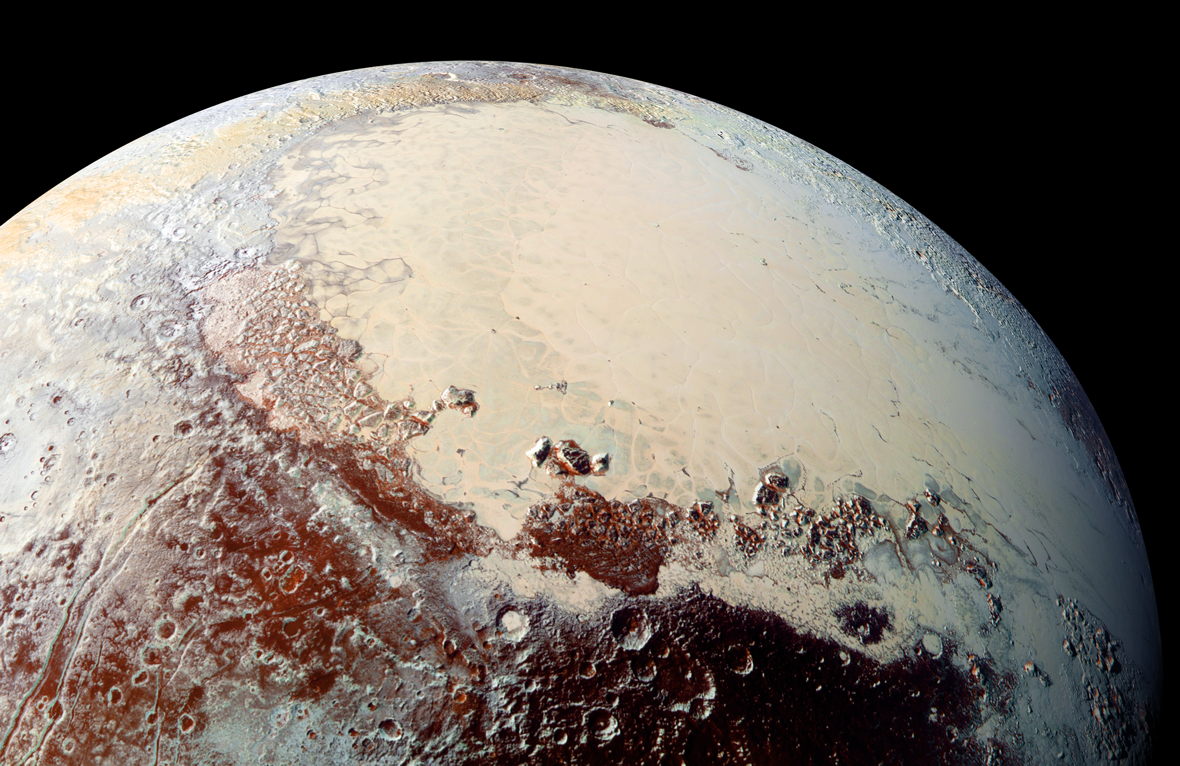
The journey to other KBOs will be an exciting one, given what has already been discovered at Pluto. New Horizons found Pluto and its moons to be surprisingly active for such small bodies so far from the Sun. Of course, scientists had made predictions, but the results were even better than hoped for. Pluto is truly an alien world, with vast glaciers and plains of nitrogen ice, mountains of water ice capped with methane snow, ancient rivers and lakes of liquid nitrogen, massive “ice spikes” reaching 500 meters tall (similar to penitentes on Earth but much larger), possible ice volcanoes, a possible subsurface ocean and a hazy blue atmosphere. Pluto’s largest moon, Charon, has tectonic canyons, mountains, and a possible former subsurface ocean, which is now thought to be frozen.
“The Pluto system data that New Horizons collected has amazed us over and over again with the beauty and complexity of Pluto and its system of moons,” said Stern. “There’s a great deal of work ahead for us to understand the 400-plus scientific observations that have all been sent to Earth. And that’s exactly what we’re going to do – after all, who knows when the next data from a spacecraft visiting Pluto will be sent?”
New Horizons is currently 3.5 billion miles (5.7 billion kilometers) from Earth.
Follow our New Horizons mission page for regular updates.
Be sure to “LIKE” AmericaSpace on Facebook and follow us on Instagram & Twitter!
Missions » New Horizons »




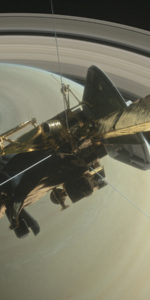
The Success of New Horizons and Cassini show the NEED for MORE Unmanned Probes to the Outer Planets. We are learning more than we ever have before and these Missions have shown that ONLY WAY TO KN OW what we want to know is to GET OUT THERE.
Alex Burford –
Also:
“The Success of New Horizons and Cassini show the NEED for” industrializing the Moon and the rest of Cislunar Space in order to build large fusion or Orion nuclear impulse spaceships capable of moving humans and our O’Neill Cylinders anywhere we want to go in our Solar System.
Thank you Paul Scott Anderson for another informative article!
“How many dwarf planets are there in the outer solar system?”
And, “As of Thu Jan 5 2017 there are:
10 objects which are nearly certainly dwarf planets,
30 objects which are highly likely to be dwarf planets,
75 objects which are likely to be dwarf planets,
148 objects which are probably dwarf planets, and
703 objects which are possibly dwarf planets.”
From: Astronomer Mike Brown
At: http://web.gps.caltech.edu/%7Embrown/dps.html
If we built large Orion nuclear pulse spaceships on the Moon we could visit and maybe even mine lots of dwarf planets, comets, and asteroids.
“Do what you can, with what you have, where you are.” ― Theodore Roosevelt
“It is hard to fail, but it is worse never to have tried to succeed.” ― Theodore Roosevelt